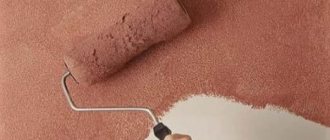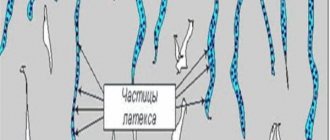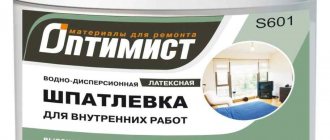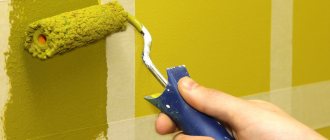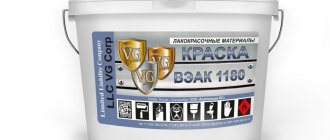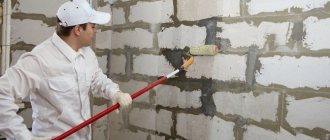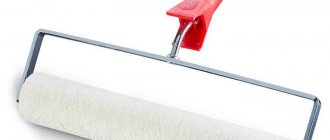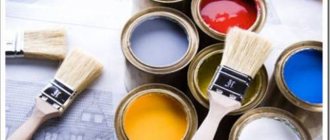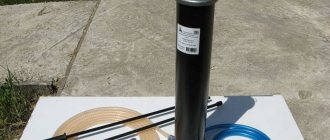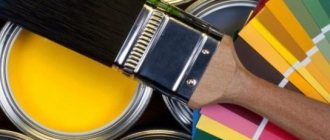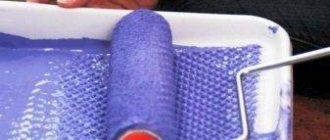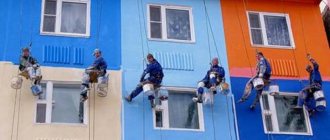Composition and features
Water-dispersed paint as a chemical compound is a mixture of tiny synthetic polymer particles and water, and the solid particles are not dissolved in it, but are suspended. Since the base is water, this paint does not burn. And after application to the surface, the water begins to evaporate, the filler particles move closer together, and the dried coating turns into a durable but breathable polymer film.
It is clear that if the solid particles did not interact with water, being completely immersed in it, then the finished coating would be very resistant to moisture.
Materials such as water-based dispersion paint and water-based paint are often confused, the differences between which are really insignificant, since a water-based emulsion is one of the types of dispersion systems, but the binding components in it are not in solid, but in liquid form, but they also do not mix with water.
Water emulsion under a microscope Source npfselena.ru
In addition to polymer fillers, dispersion paints may also contain mineral fillers - chalk, marble chips, talc. They improve their physical characteristics and affect their texture.
Also includes:
- binders (film formers), responsible for the formation of a film from dispersion components firmly adhered to each other and to the base;
- additives to improve the installation and performance properties of paint: its water resistance, resistance to fading, low temperatures, etc.;
- pigments to give color.
For reference! Water-based dispersion paint is produced mainly in white color; pigments are added to it before use.
After adding color, the paint is mixed until a uniform color Source couo.ru
See also: Catalog of companies that specialize in paints and varnishes and related work
Advantages and disadvantages
We looked at what dispersion paint is. Now let's highlight its advantages and disadvantages. The first thing worth noting is that the product is safe and environmentally friendly due to the use of water as a solvent. The paint does not have an unpleasant odor, it does not burn, and mold and mildew do not form on the painted surface - this means that the paint breathes.
The lifespan of the dye is about 15 years. In this case, the material will not swell or crack. It takes about two hours for the layer to dry completely. Also among the advantages is the affordable price.
The material is easy to use and easy to use even without skills. Rollers or brushes are suitable for applying to the surface.
There are also disadvantages - the quality of the treated surface depends on the weather. Do not paint during precipitation or low temperatures. During precipitation, the water will not evaporate. Painting at high temperatures is also not recommended. Before starting work, you need to prepare the surface - you need it to be level. A thin layer of paint will not be able to hide unevenness. Another disadvantage is that the price may be higher than those products that use other solvents.
Types of high pressure paints
The type of material determines the main binder in its composition. These can be acrylic resins, polyvinyl acetate (familiar to all PVA) and butadiene styrene (synthetic latex).
- Water-dispersion acrylic paint is more expensive than other types, but due to its excellent characteristics, its scope of application is the widest.
- Latex dispersion is cheaper than acrylic, has higher moisture resistance, but is afraid of sunlight, fading or turning yellow with constant exposure.
- Polyvinyl acetate compounds are the cheapest, but their level of moisture resistance is low and they cannot withstand prolonged frosts.
PVA-based paints are used mainly for ceilings, as they “stain” Source market-crimea.com
Disadvantages of water-dispersed coatings
With all its advantages, water-dispersion paint also has features that many would consider disadvantages:
- The material can only be stored at room temperature (0...+30 °C). When overcooled, the dispersion deteriorates.
- VDC should be applied at temperatures from +5°C and humidity up to 80%. In other conditions, the coating film will not form (in the cold it will crack, and in high humidity the paint simply will not dry).
- Undried paint should be protected from precipitation for at least a day. In the first hours after application, rain will wash it away, and in the future it will shorten the service life of the coating.
- When painting in the heat or exposed to sunlight, the dispersion dries too quickly. Stains and brush marks remain on the coating.
- Water-dispersed coatings produce a thinner film than solvent-soluble ones. Because of this, the surface for their application must be prepared more carefully.
On a note! Water-based paints are more expensive than solvent-based paints. But at the same time, you can save on solvents for diluting the dispersion and washing instruments.
Water-based paints are much more expensive than others, but have a number of other advantages
Main advantages
Dispersion paint is made on the basis of water, and is brought to the desired consistency with it, without the participation of any solvents. This makes it harmless and eliminates the appearance of an unpleasant odor both during application and during drying.
Another advantage directly related to the water base is rapid drying, during which only water vapor is released into the surrounding space. For the paint to stop getting dirty and sticking to your hands, one or two hours is enough, some people need even less. And for the coating to achieve operational strength, a maximum of 4-6 hours is required.
The second layer can be applied within a couple of hours, which speeds up repairs Source uaeu.top
Rules for surface preparation before painting
Water-dispersed paint does not tolerate violations in painting technology. Any mistake can lead to it flying off the surface immediately after drying or, at best, for several months. To obtain a durable coating, you must follow the rules for preparing the surface to be painted:
- The first thing you need to do is remove dust, dirt, grease, mold, and loose old coatings from it. The best way is to rinse with a detergent solution, then with clean water.
- Before painting, walls and ceilings should be leveled with plaster and treated with a primer. Loose places should be strengthened or replaced.
- Areas affected by mold should be treated with a penetrating fungicide.
- Any damp surface should be dried before painting. In particular, the plaster, primer and fungicidal impregnation must be completely dry.
- Previously painted surfaces must be sanded to a matte finish to improve adhesion.
- Wood, on the contrary, should be sanded to achieve maximum smoothness.
Before using water-dispersion paint, the surface must be primed and thoroughly dried.
Where is it used?
Having studied all the characteristics of the material, it is easy to come to the conclusion that the scope of its application, although limited to internal work, is very extensive. You just need to carefully study the composition and recommendations on the packaging and correlate them with the requirements for the object being painted.
The most versatile application is water-dispersion acrylic paint, the technical characteristics of which allow it to be used for painting walls, ceilings, wooden cornices and baseboards, doors, and furniture. Moreover, both in dry and wet conditions, in living rooms and utility rooms. Acrylic paints can also be used for exterior work, but only if they have the appropriate marking or the name “facade”.
Features of applying disperse paints
Painting with water-dispersed materials is as easy as painting with water-based emulsions. Even a person without special painting skills can work with them. But you need to consider the following:
- Immediately before starting painting, the paint must be thoroughly mixed.
- If it is necessary to tint the composition, the dry coloring pigment is first moistened in water and then mixed with the dispersion.
- Water-dispersed coatings can be applied with a brush, roller or spray gun. When painting large surfaces (walls, ceilings, floors), it is advisable not to use a brush - it is difficult to create an even coating with it.
- The compositions are applied in one or two to three layers (depending on the type of surface and paintwork).
Important! After applying the first layer of paint (varnish), the wooden surface must be sanded again to remove any raised lint. Without intermediate sanding, the finished coating will be rough and sloppy.
- Instruments after VDK cannot be washed with organic solvents. They cause coagulation of the polymer, and the pile becomes clogged with lumps.
To apply VDC it is better to use a roller; it allows you to create a more even coating.
Water-based paints have many features. But if you approach the selection and application of the dispersion with skill, you can easily get a beautiful, strong and durable coating.
Differences between water-based paints
You already know what is the difference between water-based paint and water-dispersion paint in terms of chemical composition and structure. But for the consumer it is much more important which one has better characteristics. Let's compare the main ones.
- Moisture resistance is higher for dispersion paints (except polyvinyl acetate).
- Mechanical strength and abrasion are also better for dispersions.
- Aqueous emulsions win in terms of price - they are cheaper.
One of the most important characteristics of any paint is the degree of hiding power, the ability to properly paint the base. It cannot be said that water-emulsion paint is better than water-dispersion paint in this regard or vice versa. This indicator rather depends on the manufacturer and the technical conditions under which the composition is produced, as well as on its consistency.
Water-dispersible polyvinyl acetate paint
This type is very narrowly focused and is suitable for rooms with low humidity levels. Legally refers to a type of dispersion paint for interior work. Its use is recommended not only in residential buildings, but also in office buildings or other facilities with good ventilation.
Read here! How to choose a paint color? Color mixing tables and tips for choosing optimal shade combinations
In addition, it is possible to paint structures made of various materials. The advantages of this type include the fairly low cost of the original product and attractive appearance.
Dispersion paint for interior work based on butadiene styrene.
Just like the previous type, paint based on styrene-butadiene dispersion has its advantages and disadvantages. The advantage is high water-repellent properties. Therefore, their use in objects with sufficient humidity or the presence of water sources is practically unlimited.
It is not recommended to paint building facades, outdoor objects, or interior walls or objects in areas with sufficient natural light and in cold areas. This is due to the instability of butadiene styrene paint to temperature changes and constant sunlight.
Advantages of acrylic dispersions
Aqueous dispersion dyes with acrylic-based binders are widely used due to their versatility and high performance characteristics.
The main advantages of water-dispersed acrylic paint:
- Dyes create elastic coatings that smooth out unevenness and bridge microcracks.
- They tolerate ultraviolet radiation well and do not fade for a long time under the influence of direct sunlight.
- They have high strength and water-repellent characteristics.
- Capable of allowing air and water vapor to pass through and “breathe”.
- Excellent tinting using various coloring systems. More than 10 thousand colors and shades of acrylic paints are known.
This paint has other advantages:
- High temperature resistance: paints do not melt or spread at high temperatures. External coatings tolerate heat well, while internal coatings tolerate the proximity of heating devices.
- Frost resistance. The paint layer retains its integrity and performance properties in frost conditions of -30˚C.
- Long service life: the coating maintains its quality for 10 years.
The only relative disadvantage of water-based acrylic paints is their higher price than dispersion compositions based on other binders.
Working with VDK
The use of interior water-dispersion paints is available even to a person without experience in finishing work.
Tools
It is convenient to paint large surfaces with VD paint using a spray gun, if you have one, but you can get by with the simplest and most affordable tools:
- paint roller,
- telescopic handle to the roller for those who prefer to work while standing on the floor;
- a tray (cuvette) with a ribbed platform for removing excess material from the roller;
- wide brush for painting corners and joints;
- a narrow brush for painting hard-to-reach places and areas that require special care (around sockets and switches, for example);
- masking tape is useful for protecting baseboards if they have not been previously dismantled, and borders with other areas that cannot be painted.
Interesting: masking tape can be used when painting one wall in different colors. This design technique is called zoning and allows you to conditionally divide the space in a room into several parts, different in functional purpose: a work area (computer desk and office chair), a rest area (sofa and TV), and so on.
Preparing for painting
Water-dispersion paint forms a thin film on the surface, which, although it covers small cracks, is still unable to smooth out all the flaws and irregularities. In order for the walls or ceiling to look perfect after finishing, they will have to be properly prepared.
- When the surface is in good condition, that is, the old coating lies flat or is completely absent, you just need to wash it with soap and dry it. If there is a problem in the form of peeling old paint, chips, deep cracks, more serious intervention will be required: the unusable layer of material is cleaned off with a spatula or scraper; in particularly difficult cases, use a drill with a special attachment.
- The cleaned surface is treated with a vacuum cleaner and leveled with starting putty, and after it dries, with finishing putty. All roughness is rubbed down with sandpaper. Clean from dust again.
- A smooth, clean and dry wall must be primed to achieve maximum strong adhesion of the paint to the surface. It’s good if the primer contains antiseptics, this guarantees protection against putrefactive bacteria and fungi.
Coloring
First of all, the coloring composition needs to be mixed. A construction mixer or drill with an appropriate attachment is suitable for this.
Paint is applied to the corners with a wide brush, and border areas and difficult areas are painted with a narrow brush. Now you can pour the solution into the cuvette and start working with the roller properly, soaking it and freeing it of excess liquid to avoid drips.
Walls are always painted from above, the roller is rolled in vertical and horizontal directions alternately, gradually moving to the very bottom of the wall.
To paint the ceiling, it is important to know: no matter how many layers are placed on the surface, the last of them must be applied perpendicular to the wall with the window, that is, to the natural light source. If you take this nuance into account, the ceiling will look most advantageous; dark stripes and spots will not appear on it.
Application methods
Several methods of painting surfaces are used in repair and construction work:
- brush;
- roller;
- air and airless spray.
Acrylic dispersion paint contains water, and this is the basis for the following rules:
- The material is applied at air and working surface temperatures of +5 °C and above (unless there are additional instructions).
- Do not apply to wet or unsanded surfaces painted with glossy paints.
- It is advisable to use corrosion-resistant painting tools. After work, they must be thoroughly washed and dried.
- During the application process, do not spill the prepared paint; after drying, it is very difficult to remove.
- You can start using painted products and surfaces no earlier than one day later. Despite the fact that the paint sets very quickly, the declared properties appear approximately a week after application.
Usually VDK is diluted with water without loss of consumer properties up to 5% by weight.
Various types of material and their consumption
Before you go to a hardware store, you need to decide what type of material will be used. After all, the specific properties of water-based paint and its consumption largely depend on the composition.
On a note! The paint consumption calculator will help you quickly calculate the required amount of material for painting walls and ceilings.
Emulsion based on acrylic resin
Currently, this variety is considered the most popular. As the name implies, the main component is acrylic resin. Additionally, various additives are added, which are responsible for acquiring the desired properties by the composition.
The resulting coating has excellent performance qualities and is not afraid of mechanical stress and moisture. Therefore, it is an excellent way to treat the façade of a building.
Acrylic emulsion has a standard consumption per 1 square meter: when applying the first layer - from 180 to 250 g, the second layer will require 150 g. This depends on the base material and application technology.
Silicone based emulsion
The main component of this paint is silicone. The peculiarity of this variety is that it creates a surface with excellent vapor permeability.
This paint can be used on the floor; it prevents the formation of fungus and mold. This is also an excellent solution for walls with numerous cracks no larger than two millimeters in size. Unlike the previous type, this is a good option for interior work.
The first layer of silicone emulsion will require 300 grams per 1m2. For 2 layers with the same parameters - only 150 g.
Emulsions with added silicates
The material contains liquid glass. It is due to this that the surface is very resistant to various influences.
But even taking into account the long service life, which can be tens of years, the composition does not like high humidity. This limits its scope of use.
When applying the first layer, you will need 400 g, the second - from 300 to 350 g per square meter of surface.
Mineral based solution
This product contains slaked lime or cement. This material has proven itself to be exceptionally suitable for indoor work on concrete or brick surfaces.
The standard consumption rate of such water-based paint per 1 m2 is 550 and 350 grams for the first and second layers, respectively.
There is also a polyvinyl acetate emulsion on sale, which includes PVA glue. This composition is characterized by exceptional instability to any manifestations of humidity. For 1 square meter you will need almost the same amount as a mixture based on minerals.
On a note! Nowadays, paints are available in spray cans. They differ in that it is quite difficult to predict their consumption, even taking into account the standards specified by the manufacturer. In addition, such compositions have a strong chemical smell.
Professional secrets for interior work
The paint can be used for indoor work, but the requirements must be followed. After covering the walls, the humidity level in the room increases. To quickly harden the layer, you need to install a fan.
To obtain an even coating, you must follow the following rules and recommendations:
To evenly cover a plastered façade, at least 3 layers of paint are required.
- application from top to bottom;
- first use a brush to paint over all hard-to-reach areas and irregularities;
- wait 4-5 hours between applying each layer;
- if the surface absorbs the material quickly and well, it is covered with 3-4 layers;
- before work, the plinths are removed;
- If you plan to paint the wall in several colors, you can use construction tape.
Ready-made stencils are intended for decorating walls. Recently, special rollers have appeared, the surface of which has a texture. They are used to create complex decorative elements.
Purchase and storage of coverage
On the Internet, on various industrial and construction portals, you can find a lot of proposals for the implementation of acrylic VDK.
Serious companies always guarantee the quality of any paint coating, provide it with reliable storage conditions, and they usually do not have any difficulties with delivery of the goods.
The presence of water in paint components creates some restrictions on storage and transportation methods.
Containers for these purposes must be made of corrosion-resistant materials - stainless or polymer.
VDK cannot be stored at sub-zero temperatures . The permissible freezing limit is no more than 5 times. Transportation is allowed for one month at a temperature of −20 °C, if this can be controlled. This is the only minor drawback for the consumer.
New technologies for the production of acrylic water dispersions make it possible to use their unique properties to coat almost any materials and structures, increasing their resistance to fire and corrosion.
They are not inferior in quality to pentaphthalic paints for painting wooden surfaces, but they dry very quickly and do not have toxic fumes with an unpleasant odor.
This encourages buyers to choose VD-AK and forget about the usual enamels and varnishes collecting dust on the shelves.
What is dispersion paint, what type of finishing work is it suitable for, and what are the advantages or disadvantages of this material - all this is useful to know when choosing paint and varnish materials for repairs.
